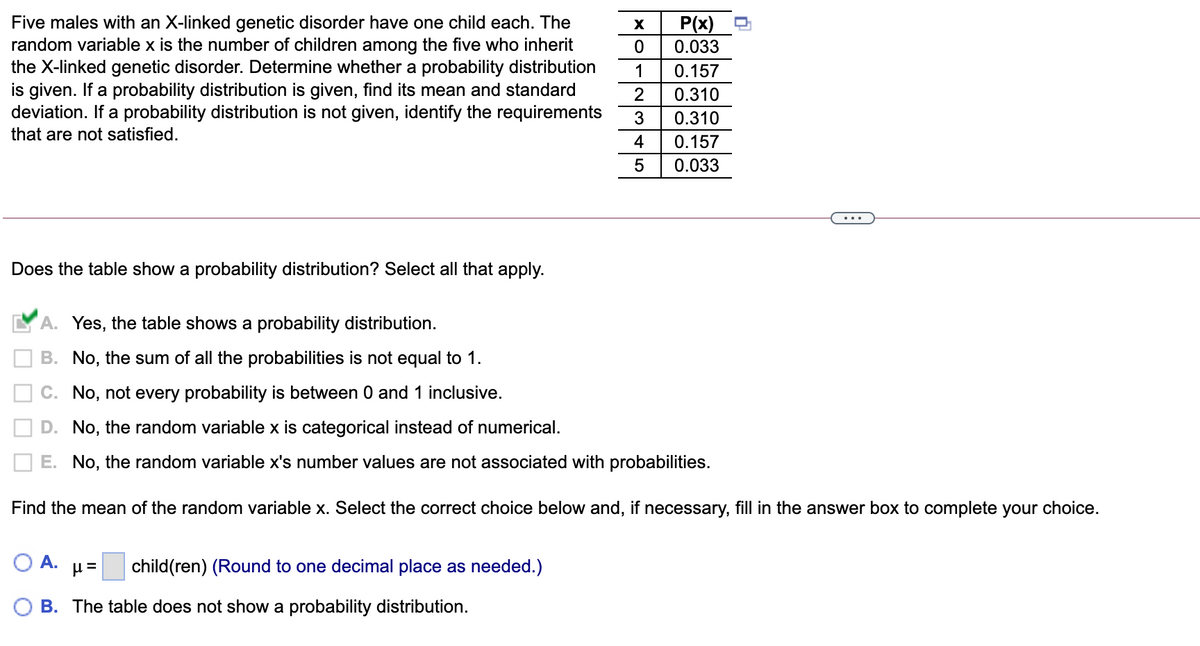P(x) O 0.033 Five males with an X-linked genetic disorder have one child each. The random variable x is the number of children among the five who inherit the X-linked genetic disorder. Determine whether a probability distribution is given. If a probability distribution is given, find its mean and standard deviation. If a probability distribution is not given, identify the requirements that are not satisfied. 1 0.157 2 0.310 3 0.310 4 0.157 5 0.033 Does the table show a probability distribution? Select all that apply. A. Yes, the table shows a probability distribution. O B. No, the sum of all the probabilities is not equal to 1. O C. No, not every probability is between 0 and 1 inclusive. O D. No, the random variable x is categorical instead of numerical. O E. No, the random variable x's number values are not associated with probabilities. Find the mean of the random variable x. Select the correct choice below and, if necessary, fill in the answer box to complete your choice. O A. child(ren) (Round to one decimal place as needed.) O B. The table does not show a probability distribution.
P(x) O 0.033 Five males with an X-linked genetic disorder have one child each. The random variable x is the number of children among the five who inherit the X-linked genetic disorder. Determine whether a probability distribution is given. If a probability distribution is given, find its mean and standard deviation. If a probability distribution is not given, identify the requirements that are not satisfied. 1 0.157 2 0.310 3 0.310 4 0.157 5 0.033 Does the table show a probability distribution? Select all that apply. A. Yes, the table shows a probability distribution. O B. No, the sum of all the probabilities is not equal to 1. O C. No, not every probability is between 0 and 1 inclusive. O D. No, the random variable x is categorical instead of numerical. O E. No, the random variable x's number values are not associated with probabilities. Find the mean of the random variable x. Select the correct choice below and, if necessary, fill in the answer box to complete your choice. O A. child(ren) (Round to one decimal place as needed.) O B. The table does not show a probability distribution.
College Algebra
7th Edition
ISBN:9781305115545
Author:James Stewart, Lothar Redlin, Saleem Watson
Publisher:James Stewart, Lothar Redlin, Saleem Watson
Chapter9: Counting And Probability
Section9.3: Binomial Probability
Problem 2E: If a binomial experiment has probability p success, then the probability of failure is...
Related questions
Question

Transcribed Image Text:P(x)
0.033
Five males with an X-linked genetic disorder have one child each. The
random variable x is the number of children among the five who inherit
the X-linked genetic disorder. Determine whether a probability distribution
is given. If a probability distribution is given, find its mean and standard
1
0.157
2
0.310
deviation. If a probability distribution is not given, identify the requirements
3
0.310
that are not satisfied.
4
0.157
5
0.033
Does the table show a probability distribution? Select all that apply.
A. Yes, the table shows a probability distribution.
B. No, the sum of all the probabilities is not equal to 1.
C. No, not every probability is between 0 and 1 inclusive.
D. No, the random variable x is categorical instead of numerical.
E. No, the random variable x's number values are not associated with probabilities.
Find the mean of the random variable x. Select the correct choice below and, if necessary, fill in the answer box to complete your choice.
А.
child(ren) (Round to one decimal place as needed.)
O B. The table does not show a probability distribution.
Expert Solution
This question has been solved!
Explore an expertly crafted, step-by-step solution for a thorough understanding of key concepts.
This is a popular solution!
Trending now
This is a popular solution!
Step by step
Solved in 5 steps with 1 images

Recommended textbooks for you

College Algebra
Algebra
ISBN:
9781305115545
Author:
James Stewart, Lothar Redlin, Saleem Watson
Publisher:
Cengage Learning

College Algebra
Algebra
ISBN:
9781305115545
Author:
James Stewart, Lothar Redlin, Saleem Watson
Publisher:
Cengage Learning